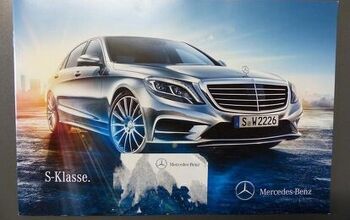Mercedes-Benz's S-Class Is Selling Like It's 2007
Mercedes-Benz USA has already sold more copies of the all-conquering S-Class in 2014 than in the full calendar years of 2009, 2010, 2011, 2012, and 2013. By the end of October, Mercedes-Benz USA’s S-Class sales total will be in excess of 2008’s total, as well.
Not since 2007 have S-Class sales been this strong. Mercedes-Benz sold 30,886 S-Class sedans in the United States in 2006 and 26,081 in 2007 after averaging little more than 20,000 annual U.S. sales between 2002 and 2005.
(Mercedes-Benz’s decision to throw the CL-Class coupe nameplate under the S-Class’s banner doesn’t mean much in this historical context, as the CL-Class has always operated in a narrow niche in the market. It accounted for 4% of all S/CL sales in 2006 and 3% last year. The coupe only accounts for 2% of the currently inventoried S-Classes.)
While this category has traditionally belonged to the S-Class, so much so that any new entry is considered as much an S-Class fighter as it is a flagship luxury sedan in its own right, there have been times in the recent past when alternatives have led the way. Going back as far as 2002, both the BMW 7-Series and even better-selling (and more affordable) Lexus LS outsold the S-Class. (They both did so again in 2005.) In fact, the LS outsold the S-Class in 2003, 2004, 2005, 2007, 2008, and 2009.
The S-Class has beaten off all challenges from top-level, premium brand sedans in each of the last four years, however, and through the first three-quarters of 2014 it has sold more than twice as often as any direct rival.
S-Class sales have risen 122% to 16,915 units so far this year. BMW 7-Series sales are down 27% to 6264 units, the Lexus LS is down 22% to 5904, the Audi A8 is down 12% to 4060, and the Jaguar XJ is down 15% to 3468.
It’s estimated that Tesla has sold around 12,000 copies of the Model S in the United States during the first three-quarters of 2014. BMW’s 6-Series range, now available as a four-door, is 371 sales ahead of the 7-Series. The Audi A7 and Mercedes-Benz CLS sit in between the E-Class/5-Series/A6 and S-Class/7-Series/A8 lineups. Their sales are up 6% to 6386 and up 4% to 6149, respectively.
In other words, the S-Class doesn’t simply outsell its rivals, it roundly trounces them.
It helps to be the newest, it helps to be the progenitor, and it helps to offer a broader lineup of available sedans. S-Class volume has now increased in twelve consecutive months.
Through three-quarters, BMW USA has outsold Mercedes-Benz USA (excluding Sprinter) by 3380 units. Yet while BMW generates 2.6% of its volume with the 7-Series (Lexus is at 2.7% with the LS; Audi ‘s at 3.1% with A8; JLR’s at 6.9% with Jaguar XJ), Mercedes-Benz produces 7.3% of its volume with the S-Class.
That figure has grown from 3.5% last year, but it’s down from 10.3% in 2007, the last time S-Class sales were this high, before the brand produced 12.9% of its volume with vehicles like the CLA and GLA, as Mercedes-Benz did in September.
Timothy Cain is the founder of GoodCarBadCar.net, which obsesses over the free and frequent publication of U.S. and Canadian auto sales figures.
More by Timothy Cain
Latest Car Reviews
Read moreLatest Product Reviews
Read moreRecent Comments
- Honda1 Unions were needed back in the early days, not needed know. There are plenty of rules and regulations and government agencies that keep companies in line. It's just a money grad and nothing more. Fain is a punk!
- 1995 SC If the necessary number of employees vote to unionize then yes, they should be unionized. That's how it works.
- Sobhuza Trooper That Dave Thomas fella sounds like the kind of twit who is oh-so-quick to tell us how easy and fun the bus is for any and all of your personal transportation needs. The time to get to and from the bus stop is never a concern. The time waiting for the bus is never a concern. The time waiting for a connection (if there is one) is never a concern. The weather is never a concern. Whatever you might be carrying or intend to purchase is never a concern. Nope, Boo Cars! Yeah Buses! Buses rule!Needless to say, these twits don't actual take the damn bus.
- MaintenanceCosts Nobody here seems to acknowledge that there are multiple use cases for cars.Some people spend all their time driving all over the country and need every mile and minute of time savings. ICE cars are better for them right now.Some people only drive locally and fly when they travel. For them, there's probably a range number that works, and they don't really need more. For the uses for which we use our EV, that would be around 150 miles. The other thing about a low range requirement is it can make 120V charging viable. If you don't drive more than an average of about 40 miles/day, you can probably get enough electrons through a wall outlet. We spent over two years charging our Bolt only through 120V, while our house was getting rebuilt, and never had an issue.Those are extremes. There are all sorts of use cases in between, which probably represent the majority of drivers. For some users, what's needed is more range. But I think for most users, what's needed is better charging. Retrofit apartment garages like Tim's with 240V outlets at every spot. Install more L3 chargers in supermarket parking lots and alongside gas stations. Make chargers that work like Tesla Superchargers as ubiquitous as gas stations, and EV charging will not be an issue for most users.
- MaintenanceCosts I don't have an opinion on whether any one plant unionizing is the right answer, but the employees sure need to have the right to organize. Unions or the credible threat of unionization are the only thing, history has proven, that can keep employers honest. Without it, we've seen over and over, the employers have complete power over the workers and feel free to exploit the workers however they see fit. (And don't tell me "oh, the workers can just leave" - in an oligopolistic industry, working conditions quickly converge, and there's not another employer right around the corner.)































Comments
Join the conversation
Meh. I've seen bear droppings with more distinctive lines. Daimler could at least put some serious effort into putting some proper aesthetics into the exterior design of the S. Look at the headlamps and taillights, ffs.
Thats a lot of numbers! If I'm not mistaken graphs and tables are invented to make numbers more readable. Can you give it a try?